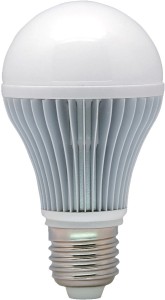Increased competition, steady cost reductions and improved technology performance are putting the LED lighting industry on a path to securing an 80 percent market share for lighting by 2020.
In a briefing this morning hosted by Credit Suisse, lighting expert and former Philips Lighting CEO Ludo Carnotensis discussed the global competitive landscape for LED lighting and said that an "aggressive scenario" of 80 percent LED penetration is "in the cards." The industry's market share was just under 12 percent in 2012 and is expected to hit 25 percent by 2014.
With revenues flattening out in the broader LED market, lighting technologies will become a more important focus for manufacturers. This will put pressure on traditional lighting companies like Philips and Osram, which are also investing heavily in LEDs. Here's how Carnotensis broke down his analysis of the evolving market for solid-state lighting.

Competition
The lighting industry has been relatively stable for the last 100 years. But as Ed Crawford, CEO of Philips Lighting North America explained to Greentech Media recently, the emergence of cost-competitive LEDs has caused a "paradigm shift" in the lighting industry that has "changed everything" for the company. Historically, the incumbents had an edge in lighting manufacturing because of the specialized glass furnaces needed for traditional bulbs. But high-volume LED production has allowed new entrants to enter the market, eating away at the share for traditional lighting companies.
"The big guys are protecting their turf," said Carnotensis. "They are trying to capture the whole value chain in order to get a competitive edge."
Carnotensis singled out Cree, a relatively new lighting entrant that now has a 10 percent market penetration, as a disruptive force. By focusing on high manufacturing output, Cree is "in search of the tipping point" on cost, he said. The company recently released an LED light bulb for less than $10 and was able to beat out Philips for shelf space at Home Depot. In addition, other LED manufacturers like Samsung and LG are investing heavily in the lighting sector, further eroding the market share of traditional companies like GE, Osram and Philips.
Increasing manufacturing volumes will also erode margins. In the past, Philips reported profits of 13 percent. Today, Cree is reporting profits of 6.5 percent, even as it ramps up production. And those margins will "continue to erode" for every company operating in the space, said Carnotensis.
"There are many more players who can print and make a product, so these margins will get squeezed," he said.
Manufacturing
As Cree is proving, the holy grail for LEDs is achieving greater volume. As companies ramp up production, the cost of an LED relative to the rest of the bill of materials is dropping by 25 percent a year. Higher volume is also the key to increasing consumer demand and for supporting innovations through R&D, said Carnotensis.
In 2009, Philips had an LED that was 80 percent more efficient than a traditional incandescent. But the light retailed for $80, and Philips sold very few of them. Instead of trying to aggressively market the product at that price point, the company focused on ramping up production to drive down costs and continue lowering prices. As a result, Philips is getting ready to release a $10 LED by the end of this year.
"There's a drive to lower price rather than add new value," said Carnotensis. The top manufacturers producing at high volumes are better positioned to invest in new technologies and production techniques that will continue to lower costs. For example, Cree continues to work on getting more light out of a single die, making LEDs brighter and reducing the number needed in a bulb.
"The success of a company will be how they can hit the big volume," said Carnotensis.
Emerging markets
The U.S., Europe, and Japan continue to drive demand for LED lighting. But the big question is what will happen in China.
Similar to what we see in solar manufacturing, China's government has helped bring a flood of new entrants to the LED lighting market. Many of these companies are already failing due to pricing pressures and their inability to produce a reliable product. And because Chinese consumers are so cost-sensitive, the domestic market for LEDs is still very small.
If you're a Chinese manufacturer, "you need to have an export market," said Carnotensis. So far, no Chinese company has emerged as a threat to the largest manufacturers.
LEDs do use rare-earth materials, however. And since China controls the vast majority of the rare-earth materials in the world, the country will continue to use its position for a trade advantage. In response, LED producers are developing new technologies that reduce the use of rare-earth materials.
In order to break into new lighting markets and compete with less expensive compact fluorescents that offer similar energy savings, LED producers will also need to market the benefits of the technology: light quality, disposal costs and controllability. The same goes for LED competition with halogens for outdoor lighting. Although a $6 LED bulb is possible for 2014, the winner of the battle will not emerge for a couple more years.
"With LEDs, you can do everything. But they're not at the right price point yet," said Carnotensis. "This year and next year will be the big breakthrough for volume, but it won't be until 2015 or 2016 when things become clear."





